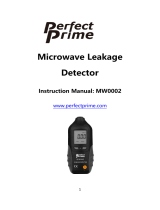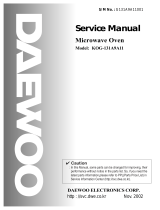Sanyo EM-F1010MW is a microwave oven with a rated power consumption of 920W and a microwave output of 600W. It has a frequency of 2,450MHz±50MHz and a power supply of 120V±12V, 60Hz. The oven has a rated current of 8 Amp and is equipped with safety devices such as a thermal fuse that opens at 332°F (167°C) for the cavity, a thermal protector that opens at 252°F (122°C) for the magnetron, and a fuse (cartridge type 15A). The oven also has a timer that can be set for up to 60 minutes.
The oven has an overall dimension of 181/16”(W)x133/4”(D)x913/1
Sanyo EM-F1010MW is a microwave oven with a rated power consumption of 920W and a microwave output of 600W. It has a frequency of 2,450MHz±50MHz and a power supply of 120V±12V, 60Hz. The oven has a rated current of 8 Amp and is equipped with safety devices such as a thermal fuse that opens at 332°F (167°C) for the cavity, a thermal protector that opens at 252°F (122°C) for the magnetron, and a fuse (cartridge type 15A). The oven also has a timer that can be set for up to 60 minutes.
The oven has an overall dimension of 181/16”(W)x133/4”(D)x913/1
















-
 1
1
-
 2
2
-
 3
3
-
 4
4
-
 5
5
-
 6
6
-
 7
7
-
 8
8
-
 9
9
-
 10
10
-
 11
11
-
 12
12
-
 13
13
-
 14
14
-
 15
15
-
 16
16
Sanyo EM-F1010MW is a microwave oven with a rated power consumption of 920W and a microwave output of 600W. It has a frequency of 2,450MHz±50MHz and a power supply of 120V±12V, 60Hz. The oven has a rated current of 8 Amp and is equipped with safety devices such as a thermal fuse that opens at 332°F (167°C) for the cavity, a thermal protector that opens at 252°F (122°C) for the magnetron, and a fuse (cartridge type 15A). The oven also has a timer that can be set for up to 60 minutes.
The oven has an overall dimension of 181/16”(W)x133/4”(D)x913/1
Ask a question and I''ll find the answer in the document
Finding information in a document is now easier with AI
Related papers
Other documents
-
Samsung M1877N-T Specification
-
Samsung MW850WA Specification
-
Samsung MC1015BB Specification
-
Kenwood KM2900M User manual
-
Garland EM-C180 User manual
-
 PerfectPrime MW0002 User manual
PerfectPrime MW0002 User manual
-
Samsung G639C User manual
-
 Perfect Prime MW0002 User manual
Perfect Prime MW0002 User manual
-
 DAEWOO ELECTRONICS KOG-131A9A11 User manual
DAEWOO ELECTRONICS KOG-131A9A11 User manual
-
Garland EM-S85 User manual


















